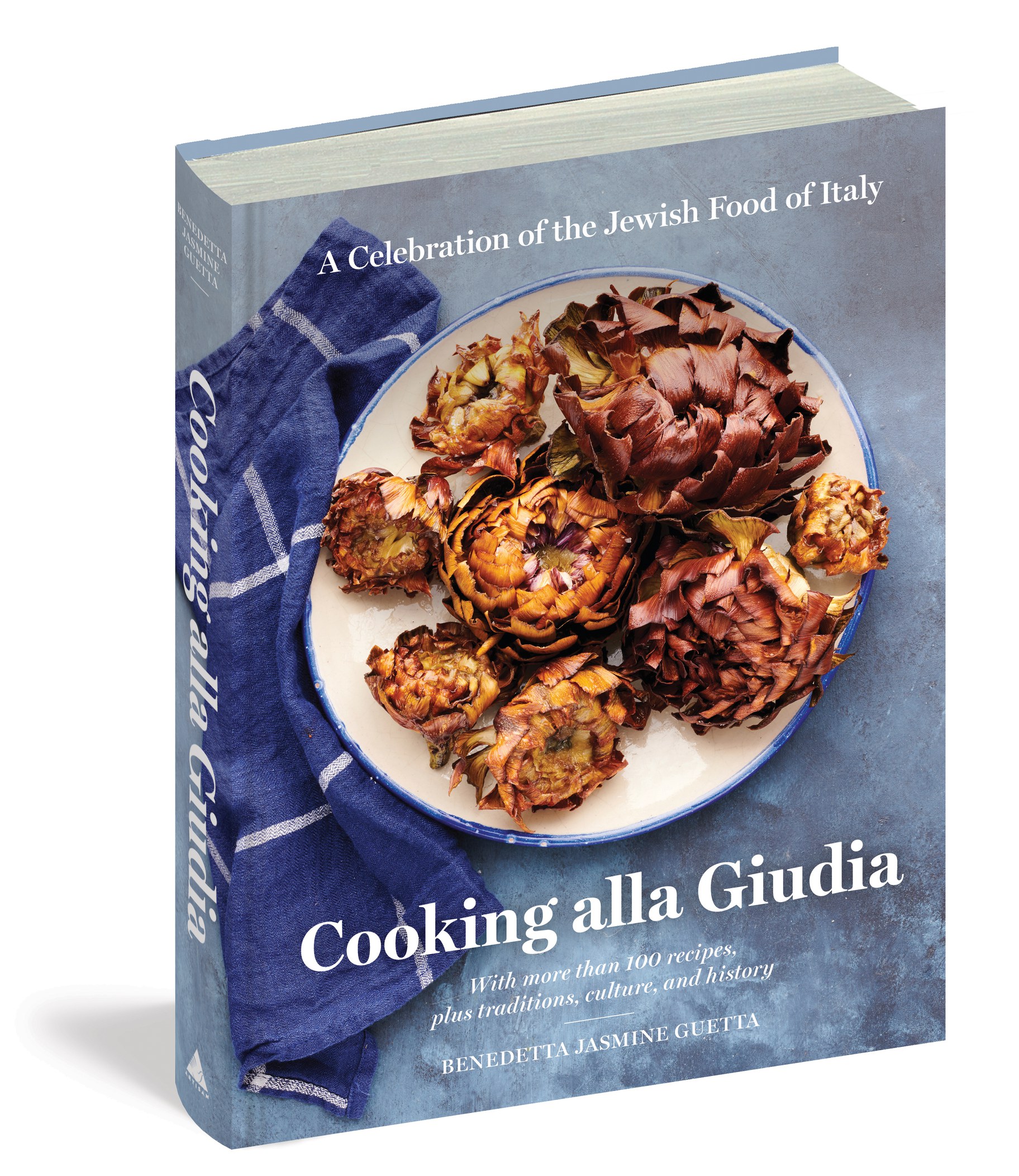“People in Italy can go their whole life without meeting a Jew, or realizing that they met one,” says cookbook author and photographer Benedetta Jasmine Guetta. With only 45,000 Italian Jews living in the country, the culture is small, but it has existed since the Roman empire. Mostly arriving from Israel as slaves, she says they had alternate fortunes ranging between persecution and being in political favor.
Guetta says the food of Italian Jews looks nothing like that of Ashkenazi Jews living in America. She explores how the Jewish culture and Italian cuisine intersect in her book, “Cooking alla Guidia.”
Eggplant wasn't introduced until the 18th century, and history books said that the vegetable was reserved for “the Jews and the dogs.” Orecchiette, Guetta says, is an ear-shaped pasta thought to have originated in Apulia, but it was actually brought to Italy by Jews via France.
Guetta operates Café LOVI, a coffee shop with signature challah sandwiches in Santa Monica.
Lasange Kasher
Dairy Free Lasagna
Serves 6 to 8
A proper Italian lasagna mixes meat (sometimes pork) and milk. Has that discouraged Jews from enjoying lasagna and even making it a festive Shabbat dish? Of course not. All you need to do is tweak the recipe a bit to make lasagna kosher, using beef rather than pork and a béchamel made with olive oil and broth instead of butter and milk.
Making lasagna from scratch is a bit of a project, but it’s all doable if you have the time. Commit to half a day of work, and you’ll be rewarded with a truly delicious dish everyone will love. However, if you don’t have much extra time, don’t hesitate to use store-bought pasta. Buy ready-made lasagna noodles, and as long as the béchamel and the ragù are homemade, nobody will know the difference.
The lasagna can be assembled ahead and kept in the fridge overnight or frozen for up to 3 months, well wrapped in foil. Transfer it to the fridge to thaw for 24 hours before you plan on baking it.
Ingredients
- ½ cup (120 ml) extra-virgin olive oil
- ¾ cup plus 1 tablespoon (100 g) all-purpose flour
- 4 cups (1 L) vegetable broth, homemade (page 78) or store-bought
- Pinch of grated nutmeg
- Kosher salt
- 1 medium onion, chopped
- 1 celery rib, peeled and chopped
- 1 small carrot, peeled and chopped
- ¼ cup (60 ml) extra-virgin olive oil
- 2¼ pounds (1 kg) ground beef chuck (20% fat)
- 1 cup (240 ml) dry red wine
- 31⁄8 cups (700 g) tomato puree (passata)
- 3 cups (720 ml) vegetable or beef broth, homemade (page 78) or store-bought, or water, plus more if needed
- 1 bay leaf
- Kosher salt
- One 9-ounce (255 g) package oven-ready lasagna sheets or a quadruple recipe Fresh Egg Pasta (page 103)
- 2 tablespoons bread crumbs or matzo crumbs for topping
Instructions
- To make the béchamel, in a large saucepan, warm the olive oil over medium heat for a minute. Add the flour and cook, whisking, until it forms a golden paste (called a roux), 3 to 4 minutes. Whisking constantly, add the broth in a slow, steady stream, then add the nutmeg and salt to taste. Bring to a gentle simmer, whisking, trying to remove lumps if there are any, and cook, whisking, until the sauce thickens, about 10 minutes. Make sure to whisk the sauce constantly so that it doesn’t stick or burn on the bottom of the saucepan. The sauce should be thick enough to coat the back of a spoon, but it should not be as thick as pudding, as it will thicken further as it cools. Remove from the heat.
- Cover the béchamel with plastic wrap and let cool to room temperature. (The béchamel can be made ahead and kept in the fridge for a couple of days, or frozen in an airtight container for up to 3 months.
Thaw it in the fridge and reheat it over low heat in a saucepan, stirring well, before using it.) - To make the ragù, pulse the onion, celery, and carrot in a food processor until finely chopped to make a soffritto.
- In a large saucepan, heat the olive oil over medium heat. Add the soffritto and cook, stirring occasionally, until the vegetables are very soft, about 5 minutes.
- Add the beef and cook, stirring often, until it is lightly browned, about 10 minutes. Pour in the wine and cook, stirring constantly, until it evaporates, about 10 minutes. Add the tomato puree, broth or water, and bay leaf and stir well.
- Reduce the heat to the lowest setting and cook, uncovered, for a couple of hours. If the liquid reduces too much, add another ½ cup (120 ml) broth or water. However, the ragù should be pretty thick when it’s ready, not too liquid. Add salt to taste, if needed, and remove from the heat.
- Discard the bay leaf and let the sauce cool to room temperature. (The ragù can made ahead and stored in the fridge for a couple of days or frozen in an airtight container. Thaw and reheat before using.)
- Preheat the oven to 350°F (180°C).
- If using fresh pasta dough, divide it into 4 portions and roll each portion into a large sheet approximately 9 by 12 inches (23 by 30 cm). Or roll into 12 smaller sheets sized 3 by 12 inches (8 by 30 cm), and use 3 of these sheets, arranged side by side in the baking dish, for each layer.
- Coat the bottom of a 9-by-13-inch (23 by 33 cm) baking dish with a layer of béchamel. Put a layer of pasta on top of the béchamel, then spread more béchamel over the pasta and top with a generous layer of ragù. (Don’t mix the béchamel and ragù together; leave them in separate layers.) Place another layer of pasta on top, then add another layer of béchamel and another of ragù. Repeat once more. Place the last layer of pasta on top and cover it with the remaining béchamel. Top with the remaining ragù, this time mixing the ragù and béchamel a bit with a spoon to obtain a marbled effect. Sprinkle the top of the lasagna with the bread or matzo crumbs so you’ll have a crunchy top.
- Bake for 40 minutes, or until the top is crunchy. Serve straightaway.
*Variation
Italian Jews don’t ever give up their lasagna, even for Passover. If you want to make lasagna for Passover, replace the egg pasta sheets with matzo, briefly soaked in beef broth, homemade (page 78) or store-bought, to soften them. To make the béchamel kosher for Passover, replace the all-purpose flour with potato starch or rice flour.

Benedetta Jasmine Guetta explains that with 45,000 Jews living in Italy, many Italians residents aren’t aware of their existence. Photo by Ray Kachatorian.

“Cooking alla Guidia,” explores the intersection of Jewish culture and Italian cuisine. Photo courtesy of Workman Publishing.
